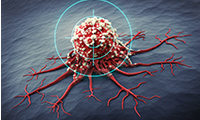Targeted Cancer Treatment
New Targeted Therapy, Effective Against Multiple Cancers
With humans now living longer than ever before, we face higher chances of being diagnosed with serious conditions such as cancer over the course of our lives. The number of diagnosed cancer cases are projected to increase through the next decade. Research, as well as sophisticated technology, has enabled the discovery of drugs that target tumor cells while leaving normal cells untouched, thus reducing some of the side effects experienced with traditional chemotherapy. Despite these efforts, many targeted drugs have limited specificity and efficacy in cancer cells.

Sumin Kang, PhD
Sumin Kang, PhD, associate professor of hematology, and her team, however, might have discovered a molecule that overcomes this problem. The molecule works by targeting a characteristic common to nearly all cancer cells, while having minimal effect on healthy normal cells.
Kang and her team have developed a molecule they call R162, which inhibits an enzyme called glutamate dehydrogenase 1 or GDH1. GDH1 plays a key role in cancer growth and metastasis. R162, by inhibiting GDH1, interrupts aberrant cell growth, and thus "targets and kills cancer cells with minimum toxicity to normal cells," Kang says.

Kang Lab
Kang's research focuses on the metabolism of tumor cells. "Cancer cell behavior is very different from normal proliferating cells," Kang explains. "Metabolism is more activated in tumor cells, so if we could target that, we could have minimal effect on normal proliferating cells."
One of the metabolic pathways that is more active in tumor cells compared to normal cells is mitochondrial glutaminolysis, a process in which the amino acid glutamine is converted into alpha-ketoglutarate (α-KG), a key component of the energy-generating process of cellular metabolism. Tumor cells predominantly use GDH1 for this process, making it an ideal target for anti-cancer treatment.
Kang's approach is similar to the way herbicides work. Weeds grow much faster than the surrounding plants and can quickly invade and overtake the garden if not treated. Herbicides target the ability of weeds to grow quickly; similarly, the molecule R162 targets a key pathway that allows tumor cells to grow uncontrollably.

Cancer Cells
Kang's team screened 2,000 molecules approved by the Food and Drug Administration (FDA) for their ability to inhibit GDH1. They found a suitable molecule – purpurin, which they modified to form cell permeable R162. When Kang's team treated various types of tumor cells with R162, they found that it "dramatically attenuated viability" of a variety of cancer cell lines but did not affect non-cancerous cells.
Kang believes that the molecule will have to be administered in combination with immunotherapy or other targeted therapy. "A molecular targeted inhibitor itself may have a limitation in completely abrogating and removing tumors," she says. "We are still testing whether to use this in combination with other targeted inhibitor or in combination with immunotherapy agents."
Kang's team tested the drug on breast and lung cancers as well as on leukemia cells and saw decreased growth in all these cell lines. Kang believes that the treatment could be "more beneficial if the cancer patients have elevated GDH1 or elevated glutaminolysis."
Since Kang's 2015 research paper on role of GDH1 and the R162 inhibitor, Kang has published another research paper on the role of GDH1 in metastasizing tumor cells in cancer patients with no tumor suppressor gene called LKB1. These studies suggest that R162 can block not only cancer growth but also metastasis in a specific cancer setting.
Sat Balachander, a licensing associate with Emory's Office of Technology Transfer, notes that this work "demonstrates the translational potential of cancer metabolism research and contributes a critical tool in the fight against cancer."
"I would like to continue studying the signaling basis for how metabolic pathways are interlinked with cellular signaling factors in tumors." Kang says. A better understanding of these cross-talks will reveal effective targets and combinatorial therapies for cancer."
Read our technology brief
Techid: 15073